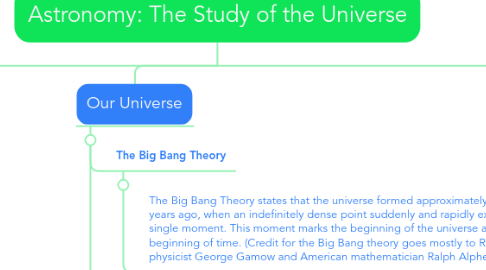
1. Astronomy and Scientific Notation
1.1. Astronomy and Scientific Notation
1.2. Astronomy is the study of the universe and the objects in it. The objects we can see in the sky are called celestial objects (celestial is a word that refers to the sky). Celestial objects include the Sun, the Moon, and Earth.
1.3. In astronomy we often deal with large numbers, whether it is to measure distances or counting number of celestial objects. To help us deal with these large numbers we use scientific notation, which is based on powers written using the base number 10.
1.4. Example of Scientific Notation: The speed of light is about 299 800 000 m/s. Write this in scientific notation. Step 1: Put a decimal point after the first digit on the left. This gives 2.99 800 000 for the example. Step 2: Count the number of places from the decimal point to the end of the zeros. For 2.99 800 000, there are eight places. This means the power of base 10 has an exponent of 8, written as 108. Step 3: Delete the zeroes. The number written in scientific notation is 2.998 × 108 m/s.
1.4.1. Questions
1.4.2. Write the following numbers in Scientific Notation: 40,000,000,000,000 km 150,000,000,000 m 13,000,000,000 ly 152,500 celestial objects 1,990,000,000,000,000,000,000,000,000,000 kg 4,550,000,000 years
1.4.3. Define the following terms: solar system, star, nuclear fusion, astronomical unit (AU), light-year (ly), asteroid belt, supernova, nebula.
2. Our Universe
2.1. The Big Bang Theory
2.1.1. The Big Bang Theory states that the universe formed approximately 13.7 billion years ago, when an indefinitely dense point suddenly and rapidly expanded in a single moment. This moment marks the beginning of the universe and also the beginning of time. (Credit for the Big Bang theory goes mostly to Russian-American physicist George Gamow and American mathematician Ralph Alpher).
2.2. Galaxies
2.2.1. Our vast universe is made up of galaxies. The galaxy we live in is the Milky Way galaxy, which measures 100,000 ly in diameter and contains 200 billion stars. Like other galaxies, the Milky Way galaxy has a black hole in the middle of it and it has been estimated to be as old as the universe itself.
2.2.1.1. Stars
2.2.1.2. Groups of stars that have recognizable forms are called constellations. One the most recognizable in the night sky is Orion. Other cultures such as the Chinese, Hindus, and Australian Aboriginals have their own constellations as well.
2.2.1.2.1. The Sun
2.2.1.2.2. At the centre of our solar system is the sun and it provides the necessary solar energy to make Earth a habitable environment for life.
2.2.1.2.3. 1) What two elements make up more than 99% of the Sun? 2) How long has the sun existed? How much longer is it expected to shine?
2.2.1.3. 1) What is a protostar? How is a protostar formed? 2) What three general mass categories do astronomers use to describe stars? What type of mass star is the Sun? 3) What type of mass star are most stars in the universe? 4) What is a supernova? What types of stars supernova?
2.2.2. 1) What do galaxies contain? 2) Astronomers believe that a black hole is at the centre of all galaxies. What is a black hole? What can the gravity of a black hole do to a star? How are supermassive black holes formed? 3) What is dark matter? What percent of the universe is considered to be dark matter? 4) Describe the 3 different shapes galaxies can have. What shape is the Milky Way galaxy?
